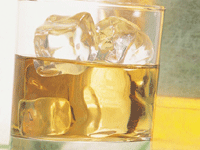Finding the proof
Don’t try this at home! To test a fermentation mixture in a brewery, pour onto a wooden seat. Sit in this puddle wearing leather breeches, while drinking more beer. Try to stand up. If breeches stick to seat, the beer will be strong. This method was used by 13th century Ale Conners, mediaeval Customs and Excise Inspectors. The stickier the mixture, the more sugar. This will produce more alcohol, so more duty is payable. Modern methods are more sophisticated, but less fun!
Have you ever heard of Degrees Proof?
You might like to …
• find out about ‘proof spirit’ and degrees proof for measuring alcohol; look for the connection between proof spirit and gunpowder; but again, don’t try this yourself!
• set up a fermentation brew with sugar and yeast; monitor its density (or specific gravity) until fermentation is complete; find out how to work out the alcohol content from the change in density
• investigate experimentally how the density of ethanol/water mixtures varies with the percentage ABV (alcohol by volume)
• measure the densities of various alcoholic drinks (NOTE: DO NOT bring alcohol into school; ask your teacher or technician to provide unidentified samples in laboratory bottles or beakers to test; treat the samples like any other chemical or food or drink test in the laboratory – do not consume [TOXIC]); convert these to ABVs as above; compare your results with the percentages shown on the labels (again, your teacher or technician should hold this information); suggest reasons for the differences
• Excise Duty (tax) must be paid on alcoholic drinks, proportional to the alcohol content; find out how the alcohol content is measured, so that Customs and Excise knows how much duty to charge.
Further links:
Have you ever heard of Degrees Proof?
You might like to …
• find out about ‘proof spirit’ and degrees proof for measuring alcohol; look for the connection between proof spirit and gunpowder; but again, don’t try this yourself!
• set up a fermentation brew with sugar and yeast; monitor its density (or specific gravity) until fermentation is complete; find out how to work out the alcohol content from the change in density
• investigate experimentally how the density of ethanol/water mixtures varies with the percentage ABV (alcohol by volume)
• measure the densities of various alcoholic drinks (NOTE: DO NOT bring alcohol into school; ask your teacher or technician to provide unidentified samples in laboratory bottles or beakers to test; treat the samples like any other chemical or food or drink test in the laboratory – do not consume [TOXIC]); convert these to ABVs as above; compare your results with the percentages shown on the labels (again, your teacher or technician should hold this information); suggest reasons for the differences
• Excise Duty (tax) must be paid on alcoholic drinks, proportional to the alcohol content; find out how the alcohol content is measured, so that Customs and Excise knows how much duty to charge.
Further links:


